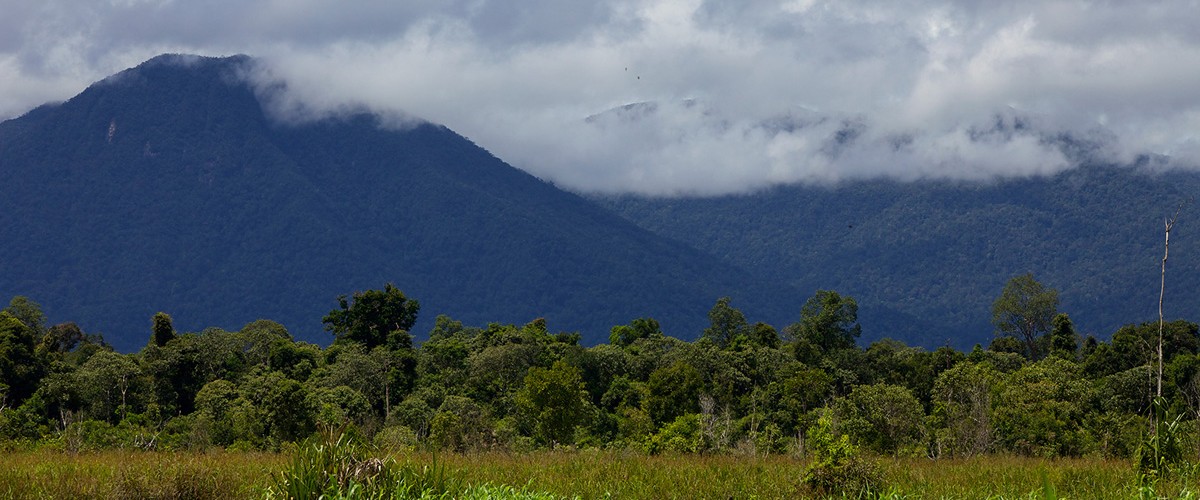My name is Sabta and I have worked as a research assistant at Cabang Panti for over 3 years. My job is to find orangutans and record their behavior so we can better understand how they live. This month I had the exciting opportunity (along with my co-workers Toto and Sahril, and Field Manager Dr. Alys Granados) to visit Tuanan Research Station in Central Kalimantan. The purpose of our visit was to see how other research stations in Indonesia collect data on orangutan behavior. To get there, we had to take a plane from Pontianak in West Kalimantan to Palangkaraya in Central Kalimantan.
|
|
|
Field assistants (from left) Toto, Sahril, and Sabta with Dr. Alys Granados – outside of Bornean Orangutan Survival Foundation research station in Tuanan.
|
Once we got to Palangkaraya, we were greeted by the Manager from Tuanan, Ipeh, who we already knew from her time as a Lab Assistent at Cabang Panti. Our journey was just getting started – the next day we had a 2 hour long car ride, followed by a 2 hour trip in a long boat to get to a village about 20 minutes from Tuanan. Once we got to the village, we walked the rest of the way on a well marked trail. It was a long day and we were all very tired and even a little nauseous from the travel, but we were happy to finally reach our destination.
As soon as we arrived at Tuanan camp, we noticed just how different Tuanan is from Cabang Panti. The main difference is that Cabang Panti has 8 different forest habitats in our trail system, whereas Tuanan only has peat swamp. Another major difference from CP is that the assistants go home each night as they live in the village 20 minutes from camp. At CP we are at least fours hour walk to the nearest village, so we stay at camp for 20 days at a time before taking our rest days at home.
|
|
|
On the boardwalk walking towards Tuanan Research Station.
|
To learn about how wild orangutans are studied at different research sites we joined the Tuanan assistants and volunteers on an orangutan follow the next day. The orangutan I followed was a mother-infant pair named Milo (the mom) and Merkur (the baby). We left camp at 4:30 am that day and then made our way through the swamp to get to the nest. We waited there until the orangutans woke up around 5am to start eating in a nearby tree. Here, I noticed another difference in how we study orangutans at CP – the assistants at Tuanan take data every 2 minutes, while we record what the orangutan is doing every 5 minutes. We also record the start and stop times of every activity. Also, when they record the type of fruit eaten by orangutans, they use the local name, whereas we use Latin names to identify fruit samples.
Since Tuanan is all peat swamp, the types of trees found in that forest also differ from CP. One of the fruits more frequently eaten is locally known as “kamundak”, which is in the same plant family as beans (Fabaceae). This fruit provides a stable source of food for wildife as its trees regularly make fruit. Apparently, orangutans at Tuanan sleep a lot if they eat too much of it. People can also feel sick after eating it which we know because a western researcher brought some back to camp to fry and ended up with a headache and a stomachache. I tried some kamundak too but only a little bit as I wanted to avoid the same fate!
|
|
|
On the boat towards Tuanan which consists of only one habitat type: peat swamp.
|
For our next day, we joined the assistants in following a flanged male named Dado. He spent most of the day eating a fruit which is common in the area and known locally as “tutup kembali.” During our time at Tuanan we also had the chance to meet with the local people in the nearby village, and at night we walked there with the researchers and assistants to play volleyball and games with the children.
|
|
|
The assistants following a large male orangutan named Dodo. The trail system is a series of boardwalks as Tuanan is all peat swamp.
|
After 4 days at Tuanan, it was already time to leave! We were all sad to go because everyone at Tuanan had been welcoming and very friendly. Although we were not there for a long time, we became close with the assistants and it was fun to exchange stories with them about working in the field. We learned a lot from them and we hope that some day soon they can can come visit us at Cabang Panti!










